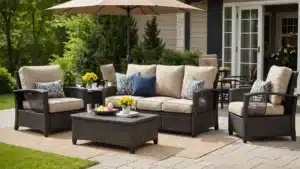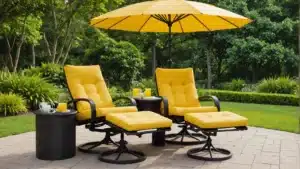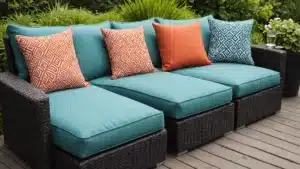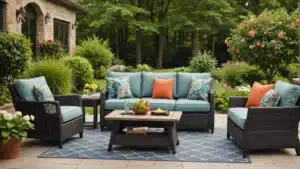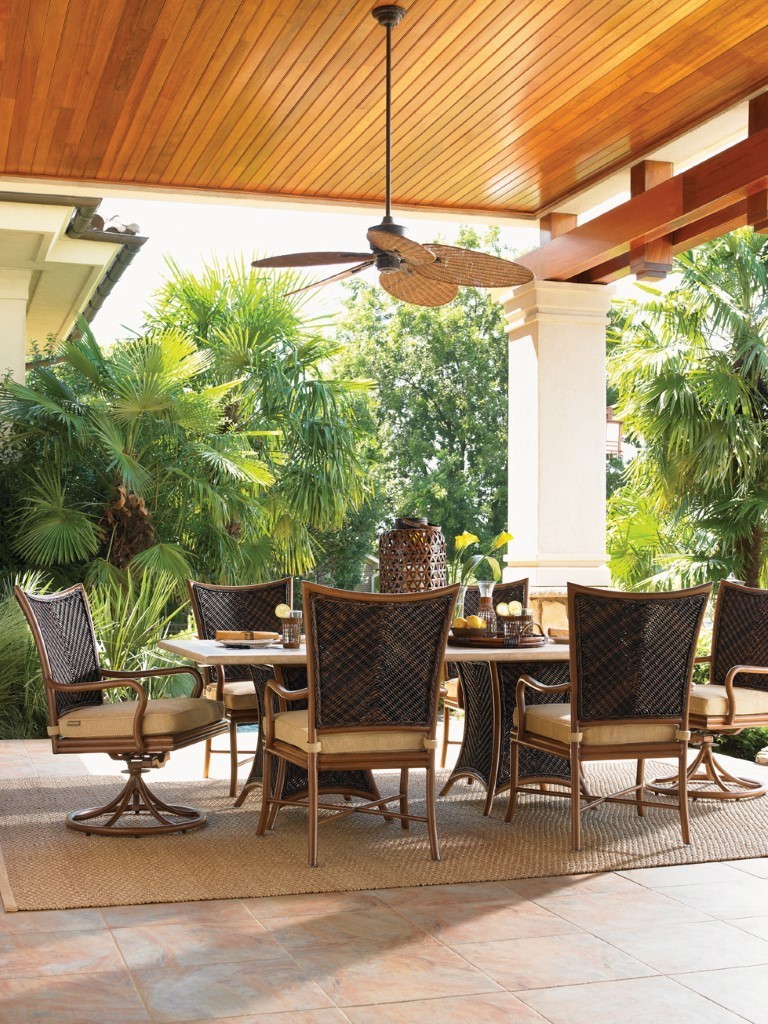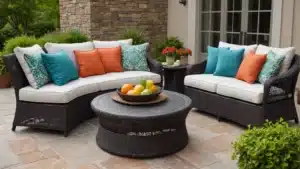Patio Furniture Maintenance and Repair Guide

Patio furniture is an essential part of any outdoor living space, providing comfort and style for gatherings, relaxation, and more. However, exposure to the elements can take a toll on even the sturdiest pieces. To ensure your patio furniture remains in top condition and lasts for years to come, regular maintenance and timely repairs are crucial. In this guide, we will share 10 practical tips for furniture repairs that will help you extend the lifespan of your patio furniture. From simple cleaning techniques to more advanced restoration methods, these tips will empower you to keep your outdoor furniture looking great and functioning well, season after season.
- Regular Cleaning
- Use mild soap and water to clean surfaces.
-
Avoid harsh chemicals that can damage finishes.
-
Protective Covers.
- Invest in high-quality covers to shield furniture from the elements.
-
Ensure covers are breathable to prevent mold and mildew.
-
Inspect for Damage.
- Regularly check for signs of wear and tear.
-
Address minor issues before they become major problems.
-
Tighten Screws and Bolts.
- Periodically tighten any loose screws or bolts.
-
Replace any missing hardware promptly.
-
Repaint or Stain.
- Refresh the look of wooden furniture with a new coat of paint or stain.
-
Use weather-resistant products for best results.
-
Replace Worn Cushions.
- Swap out old, worn cushions for new ones.
-
Choose cushions made from durable, outdoor-friendly materials.
-
Repair or Replace Slings.
- Fix any torn or sagging slings on chairs and loungers.
-
Consider replacing slings if they are beyond repair.
-
Lubricate Moving Parts.
- Apply lubricant to hinges, wheels, and other moving parts.
-
Use a silicone-based lubricant for outdoor use.
-
Store Furniture Properly.
- Store furniture in a dry, sheltered location during off-seasons.
-
Use storage solutions that allow for proper ventilation.
-
Seek Professional Help.
- For complex repairs, consider hiring a professional.
- Professional services can extend the life of your furniture significantly.
By following these tips, you can ensure that your Patio Furniture remains in excellent condition, providing comfort and style for many seasons to come.
Essential Tips for Furniture Repairs
Regular Cleaning
Keeping your furniture clean is the first step in ensuring its longevity. Dust and dirt can accumulate over time, leading to wear and tear. Use a soft cloth and mild cleaning solution to wipe down surfaces regularly. For wooden furniture, consider using a wood polish to maintain its shine and protect the finish. For upholstered furniture, vacuum regularly and use fabric cleaners to remove stains. Regular cleaning not only keeps your furniture looking good but also helps in identifying any early signs of damage that need attention.
Protecting Against Weather
Weather can be a significant factor in the deterioration of your furniture, especially if it’s kept outdoors. To protect your furniture from the elements, use covers when not in use and consider applying a weather-resistant finish. For metal furniture, a rust-resistant paint can help prevent corrosion. Additionally, consider moving outdoor furniture to a sheltered area during extreme weather conditions. For wooden outdoor furniture, applying a sealant can help protect against moisture and UV damage. Regularly inspect your furniture for any signs of weather damage and address them promptly to prevent further deterioration.
Repairing Wobbly Furniture
Wobbly furniture can be both annoying and unsafe. To fix this issue, first, identify the loose joints. You can use wood glue or a strong adhesive to secure the joints. For added stability, consider using screws or brackets to reinforce the structure. If the wobble is due to uneven legs, you can use furniture pads or leg levelers to balance it out. Regularly check the stability of your furniture and tighten any loose screws or bolts to maintain its sturdiness.
Fixing Broken Slats
Broken slats in chairs or beds can compromise the functionality and safety of the furniture. To repair broken slats, remove the damaged piece and measure a replacement. Cut a new slat from a similar material and secure it in place using screws or nails. Sand down any rough edges and finish with paint or varnish to match the rest of the furniture. If multiple slats are damaged, consider replacing all of them to ensure uniformity and strength. Regularly inspect slats for any signs of wear and replace them as needed to maintain the integrity of the furniture.
Addressing Rust Issues
Rust can be a common problem for metal furniture. To address rust issues, start by sanding down the affected area to remove the rust. Apply a rust converter to neutralize any remaining rust, then paint over the area with a rust-resistant paint. Regular maintenance, such as applying a protective coating, can help prevent rust from forming in the future. For heavily rusted areas, you may need to replace the affected parts to ensure the structural integrity of the furniture. Regularly inspect metal furniture for any signs of rust and address them promptly to prevent further damage.
Advanced Repair Techniques
Replacing Worn Cushions
Over time, cushions can become worn out and lose their comfort and aesthetic appeal. To replace worn cushions, start by measuring the dimensions of the old cushions to ensure a proper fit. Choose a durable fabric that complements your furniture and is suitable for outdoor or indoor use, depending on where the furniture is located. Consider adding a layer of foam for extra comfort. Secure the new fabric around the foam using a staple gun or sewing machine, and attach the new cushions to the furniture.
Repairing Wicker Furniture
Wicker furniture is known for its intricate design and durability, but it can become damaged over time. To repair wicker furniture, follow these steps:.
- Clean the affected area with a soft brush and soapy water.
- Allow it to dry completely.
- For minor repairs, use a clear epoxy resin to glue loose strands back into place.
- For more extensive damage, replace entire sections of the wicker. Purchase matching wicker material and weave it into the existing pattern, securing it with glue or small nails.
Maintaining Metal Furniture
Metal furniture is sturdy and long-lasting, but it requires regular maintenance to prevent rust and corrosion. Follow these steps to maintain your metal furniture:.
- Clean the metal surfaces with a mild detergent and water.
- Rinse thoroughly and dry with a soft cloth.
- Inspect the furniture for any signs of rust or damage.
- Use a wire brush or sandpaper to remove rust spots.
- Apply a rust-inhibiting primer.
- Once the primer is dry, paint the furniture with a high-quality metal paint to protect it from the elements.
Wooden Furniture Care
Wooden furniture adds a classic touch to any space, but it needs proper care to maintain its beauty. Here are some tips for caring for wooden furniture:.
- Dust the furniture regularly with a soft cloth.
- For deeper cleaning, use a wood cleaner that is appropriate for the type of wood.
- Avoid using water or harsh chemicals, as they can damage the wood.
- To repair scratches, use a wood filler that matches the color of the furniture. Sand the area lightly and apply a matching wood stain.
- Finish by applying a protective coat of wax or varnish to seal the wood and enhance its natural luster.
Regular Inspections and Maintenance
Tip 10: Regular Inspections
Regular inspections are crucial for maintaining the longevity and efficiency of your equipment. By conducting thorough checks on a consistent basis, you can identify potential issues before they escalate into costly repairs. Make it a habit to inspect all critical components, including mechanical parts, electrical systems, and safety features. Regular inspections not only help in identifying problems but also ensure that the equipment is operating at its peak performance. This proactive approach can significantly reduce downtime and increase the overall productivity of your operations. Additionally, regular inspections can help in maintaining compliance with industry standards and regulations, which is essential for avoiding legal complications and ensuring workplace safety.
Creating a Maintenance Schedule
A well-structured maintenance schedule is essential for keeping your equipment in optimal condition. Start by listing all the tasks that need to be performed and the frequency at which they should be done. This can include daily, weekly, monthly, and annual checks. Utilize digital tools or maintenance management software to keep track of completed tasks and upcoming inspections. Consistency is key, so ensure that your team adheres to the schedule diligently. A comprehensive maintenance schedule should also include detailed checklists for each type of equipment, specifying the exact steps to be taken during each inspection. This ensures that no critical aspect is overlooked and that the maintenance process is standardized across the board. Furthermore, involving your team in the creation of the maintenance schedule can foster a sense of ownership and accountability, leading to more diligent adherence to the schedule.
Identifying Early Signs of Damage
Early detection of damage can save you time and money in the long run. Train your staff to recognize the early signs of wear and tear, such as unusual noises, vibrations, or changes in performance. Encourage them to report any anomalies immediately so that corrective actions can be taken promptly. Regularly reviewing inspection reports and maintenance logs can also help in identifying patterns that may indicate underlying issues. Additionally, investing in advanced diagnostic tools can aid in the early detection of potential problems. These tools can provide real-time data and analytics, allowing for more accurate and timely interventions. By fostering a culture of vigilance and proactive maintenance, you can extend the lifespan of your equipment and ensure its reliable operation. Moreover, early identification of issues can prevent minor problems from developing into major failures, thereby reducing the risk of unexpected downtime and costly emergency repairs. Implementing a robust training program for your staff on the use of diagnostic tools and the interpretation of data can further enhance your maintenance strategy.
10 Tips for Furniture Repairs: How to Extend the Lifespan of Your Patio Furniture
- Regular Cleaning
- Frequency: Clean your patio furniture at least once a month.
- Materials: Use mild soap and water for most surfaces.
-
Tip: Avoid harsh chemicals that can damage finishes.
-
Timely Repairs.
- Inspect Regularly: Check for loose screws, broken parts, and other damages.
-
Quick Fixes: Address minor issues before they become major problems.
-
Proper Storage.
- Seasonal Storage: Store furniture indoors during harsh weather conditions.
-
Cover Up: Use protective covers to shield your furniture from the elements.
-
Invest in Quality Materials.
- Durability: Choose materials like teak, aluminum, or high-quality wicker.
-
Maintenance: Higher quality materials often require less maintenance.
-
Use Protective Covers.
- Weather Protection: Covers protect against rain, snow, and UV rays.
-
Longevity: Extend the life of your furniture by reducing exposure to the elements.
-
Apply Protective Coatings.
- Wood Furniture: Use sealants or varnishes to protect wood surfaces.
-
Metal Furniture: Apply rust-resistant coatings to prevent corrosion.
-
Avoid Direct Sunlight.
- Fading: Prolonged exposure to sunlight can cause fading and damage.
-
Placement: Position furniture in shaded areas when possible.
-
Use Cushions and Pads.
- Comfort: Cushions add comfort and style to your furniture.
-
Protection: Pads can prevent scratches and other damage to surfaces.
-
Rotate Furniture.
- Wear and Tear: Rotating furniture can distribute wear evenly.
-
Aesthetics: Changing the layout can refresh the look of your outdoor space.
-
Regularly Tighten Screws and Bolts.
- Safety: Loose screws and bolts can be a safety hazard.
- Stability: Ensure your furniture remains stable and secure.
Maintaining and repairing your patio furniture doesn’t have to be a daunting task. By following these 10 tips, you can significantly extend the lifespan of your outdoor pieces, ensuring they remain both functional and aesthetically pleasing for years to come. Regular cleaning, timely repairs, and proper storage are key to preserving the integrity of your furniture. Additionally, investing in quality materials and protective covers can save you time and money in the long run. Remember, a little effort goes a long way in keeping your patio furniture in top shape, allowing you to enjoy your outdoor space to the fullest.





